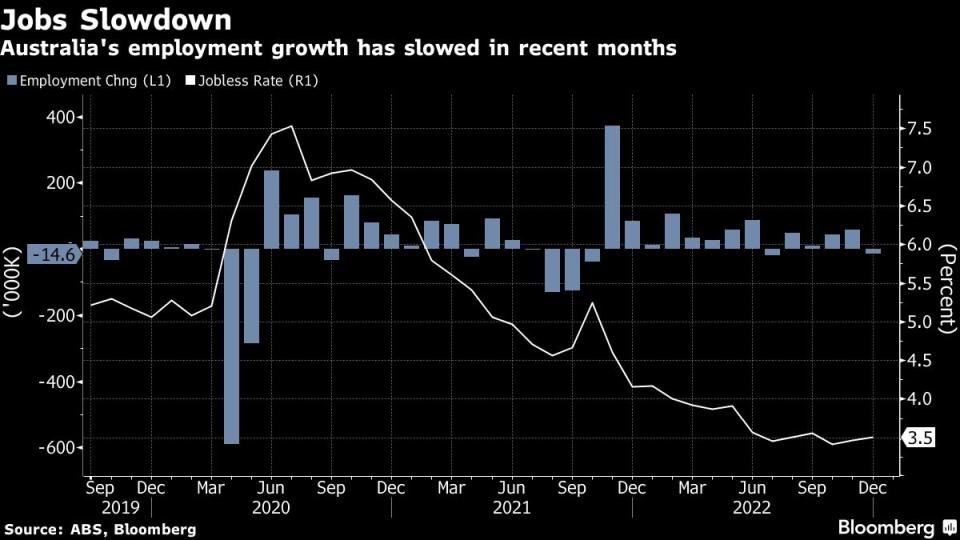Australian Jobs Surprisingly Fall, Easing Case for Rate Hike
(Bloomberg) -- Australian employment unexpectedly fell last month while the jobless rate remained unchanged, sending the currency and bond yields lower as traders pared bets on a February interest-rate increase.
Most Read from Bloomberg
New Zealand Prime Minister Ardern Announces Shock Resignation
Treasury Taps Retirement Funds to Avoid Breaching US Debt Limit
Biden Revives Housing Rule That Trump Derided as ‘Abolishing the Suburbs’
Employers cut 14,600 roles in December — the first decline in five months — confounding expectations for a 25,000 increase, official data showed Thursday. Unemployment held at 3.5% after being upwardly revised from a 48-year low.
Australian government bond yields and the currency slid after the release, which suggested the Reserve Bank’s aggressive tightening since May is beginning to take some heat out of the economy. In contrast, stocks swung to gains on prospects of a potential rate pause.
The result bolsters the case for the RBA to stand pat at a 10-year high of 3.1% at its first meeting of the year on Feb. 7. The central bank has lifted borrowing costs by 3 percentage points in consecutive monthly moves since May and discussed a pause at its December meeting.
Money market pricing implies a 50% chance of a quarter percentage-point rate rise in February, down from more than 80% prior to the data. Markets also pared back the chance of a second hike.
“There are signs that the labor market is going to weaken from here,” said Diana Mousina, a senior economist at AMP Capital Markets Ltd. “Our model of jobs growth looking ahead is pointing lower. The model include things like hiring intentions, job advertisements, job vacancies, and they’ve all been weakening off last year’s levels.”
Mousina expects the RBA will leave the cash rate unchanged, while adding that inflation data next week and retail sales the week after that will also be important in what policymakers ultimately decide.
Australia’s labor market rapidly tightened in the first half of 2022, averaging a monthly gain of 54,500 jobs, before decelerating in the second half to a still-brisk average of 30,200.
The ABS, in a statement, attributed some of last month’s weakness to a renewed outbreak of Covid-19.
“In December, we saw the number of people working reduced hours due to illness increasing by 86,000 to 606,000, which is over 50% higher than we would usually see at this time of the year,” said Lauren Ford, head of labour statistics at the ABS.
The resilience of the labor market is a key reason the central bank reckons it can engineer a soft landing in the A$2.2 trillion ($1.5 trillion) economy as policymakers raise rates to rein in inflation. The RBA expects unemployment will hover around the current level through mid-year.
But many economists forecast it will climb as job vacancies plateau and labor supply increases thanks to rapidly rising immigration.
What Bloomberg Economics Says...
“Demand for workers is cooling and supply is surging. This will cause the unemployment rate to rise through 2023 – and likely drive the central bank to reverse course and cut rates late in the year”
James McIntyre, Economist
To read the full report, click here
Today’s report also showed:
The participation rate fell to 66.6% from 66.8%
Underemployment climbed 0.3 percentage point to 6.1% and underutilization rose by the same amount to 9.6%
Full-time roles increased by 17,600, while part-time fell 32,200
Monthly hours worked declined, while the employment to population ratio also slid to 64.3%
--With assistance from Tomoko Sato.
(Updates with comments from economists.)
Most Read from Bloomberg Businessweek
Fake Meat Was Supposed to Save the World. It Became Just Another Fad
What Tech Job Cuts Say About Silicon Valley—and the Rest of the Economy
It’s a Business Free-for-All in a Russia Transformed by Sanctions
©2023 Bloomberg L.P.




